Imagine a storyboard as your project’s first draft, but instead of words, it’s full of pictures. It’s a visual plan that shows what every part of your video or film will look like, scene by scene. Think of each sketch on the storyboard example as a snapshot from your upcoming project, complete with notes about what’s happening and any important dialogue or camera moves.
Storyboards aren’t just for filmmakers or media purposes though; everyone can use them. They’re great for getting your message across clearly. Whether you’re a writer, salesperson, or teacher, storyboards can help you share information effectively. They’re versatile and useful for anyone looking to communicate ideas easily.
For those who like the idea of storyboards but don’t know where to start, this article will explain how to create one and showcase real storyboard examples to kick-start your creative ideas. We’ll also discuss why Prezi is a great platform for turning presentations into visual stories for maximum engagement.

Why are storyboards so important?
- Preview your project: A storyboard lets you see your project before it’s brought to life. It’s a great way to check if your story flows visually and to make sure your shots will look just as good in reality as they do in your imagination.
- Visual communication: Storyboards let professionals tell their stories using pictures and graphics, which can be more memorable and impactful than just words. With images and visuals, storyboards make it easier for people to understand and remember information.
- Plan with precision: In film, a storyboard example can help you figure out the specifics, like where to film, what props you’ll need, and who should be on set. They also help with the technical side, like picking the right camera angles.
- Keep everyone aligned: Think of a storyboard as a universal language for your project team. It ensures that everyone, from the director to the design team, understands the vision and direction of your project.
- Avoid costly mistakes: By identifying potential issues through your storyboard example, you can save time, effort, and money when it comes time to put your plans into action. It’s all about being one step ahead.
- Streamline editing: With a storyboard, you get a preview of how scenes will transition, which helps with the overall rhythm and pacing of your story.
- Clear structure: Storyboards help educators and professionals organize complex ideas clearly and logically, making it easier for students or team members to understand.
- Informed decision-making: In business, storyboards present options and scenarios visually, helping decision-makers evaluate choices more effectively.
- Efficient workflows: Storyboards streamline academic planning and business processes, providing a visual roadmap for tasks and timelines, leading to smoother execution and delivery.
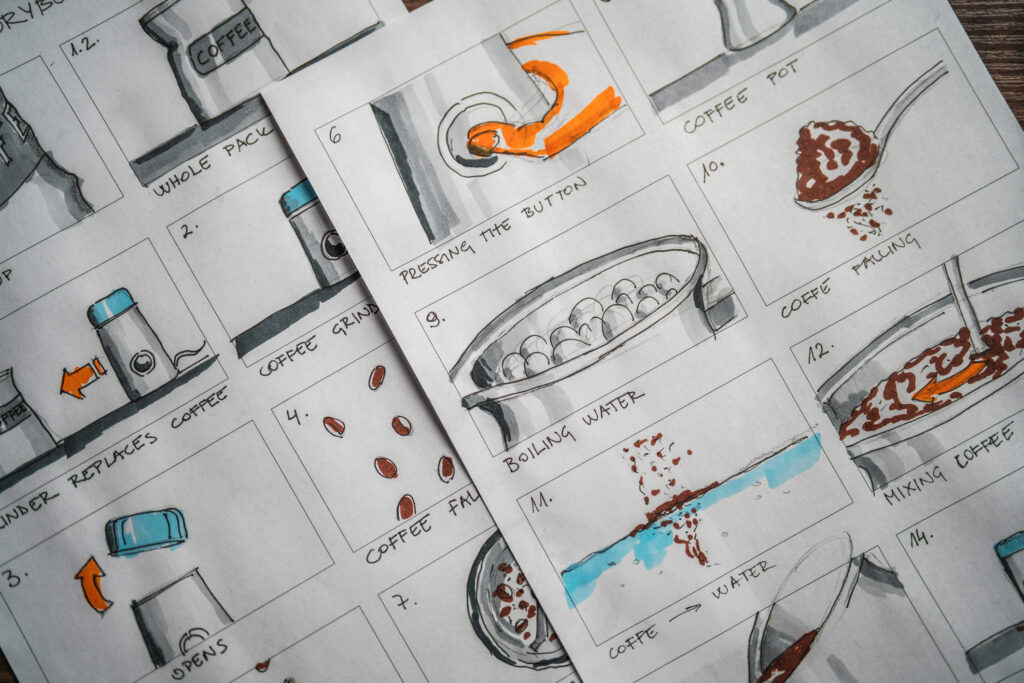
The best platform for creating your storyboard: Prezi
Prezi can revolutionize the way you create storyboards. Instead of static images, Prezi lets you build dynamic, engaging storyboards that bring your vision to life. With Prezi, you can:
- Visualize your story: Use Prezi to map out your project scene by scene, adding depth and motion to each part of your storyboard.
- Collaborate seamlessly: Share your Prezi storyboard with team members anywhere, getting feedback and ideas in real time.
Note: This feature is only available to teams with a Prezi Business plan. If you’d like to learn how your team can use Prezi Business, click here. - Present with impact: Turn your storyboard into a compelling presentation to pitch your project, showing off the flow of your narrative in a memorable way.
- Interactive experience: Prezi offers an interactive experience that goes beyond traditional storyboards. With features like zooming, panning, and animations, Prezi allows users to create dynamic presentations that keep audiences engaged and immersed in the story.
- Access storyboard examples and templates: The great thing about Prezi is that you can access other storyboard examples that have been created by other users. This is a great way to get inspiration for your storyboard. If you’re worried about your design skills, Prezi templates might be the right place to start.
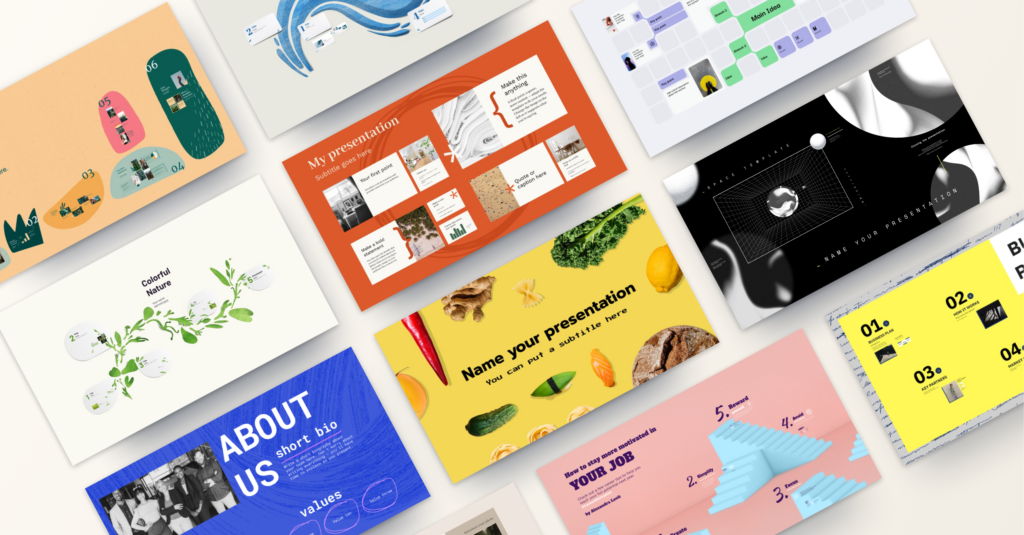
Prezi transforms the traditional storyboard into an interactive experience, making it easier to share your vision and get everyone excited about your project. Whether you’re planning a film, a marketing video, or any visual project, Prezi can help you lay the groundwork for success.
Presentation storyboard examples for different purposes
Storyboard examples for students
If a student needs to make a storyboard about the water cycle, they could structure their project by using each slide to convey a different point, showcasing the cycle’s stages and human interaction with water. Here’s a storyboard example about the water cycle:
- First slide: Introduce the topic with a captivating image of the Earth, highlighting the presence of water in various forms. This sets the stage for exploring the water cycle, with a brief overview stating, “Embark on the journey of a water droplet through the water cycle.”
- Second slide: Detail evaporation using visuals of the sun heating bodies of water, causing water to rise as vapor. This section explains how water transforms from liquid to gas, with a note: “Evaporation: The sun’s warmth turns water into vapor.”
- Third slide: Show condensation through images of clouds forming. Here, the student can describe how water vapor cools and condenses into liquid, forming clouds, with a simple explanation: “Condensation: Cooling water vapor turns back into liquid in the clouds.”
- Fourth slide: Illustrate precipitation with rain or snow falling from clouds onto the Earth. This part emphasizes the process of water returning to the ground, with the text saying, “Precipitation: Clouds release water as rain or snow, completing the journey from sky to earth.”
- Fifth slide: Highlight the collection of water in rivers, lakes, and oceans, where all precipitation gathers, ready to start the cycle over. A concise description could be: “Collection: Water flows back to large bodies, ready to evaporate again.”
- Sixth slide: Address human interaction, showing how we use water for agriculture, drinking, and industry, and underline the importance of conservation with a message like, “Humans and the Water Cycle: Our role in using and protecting water.
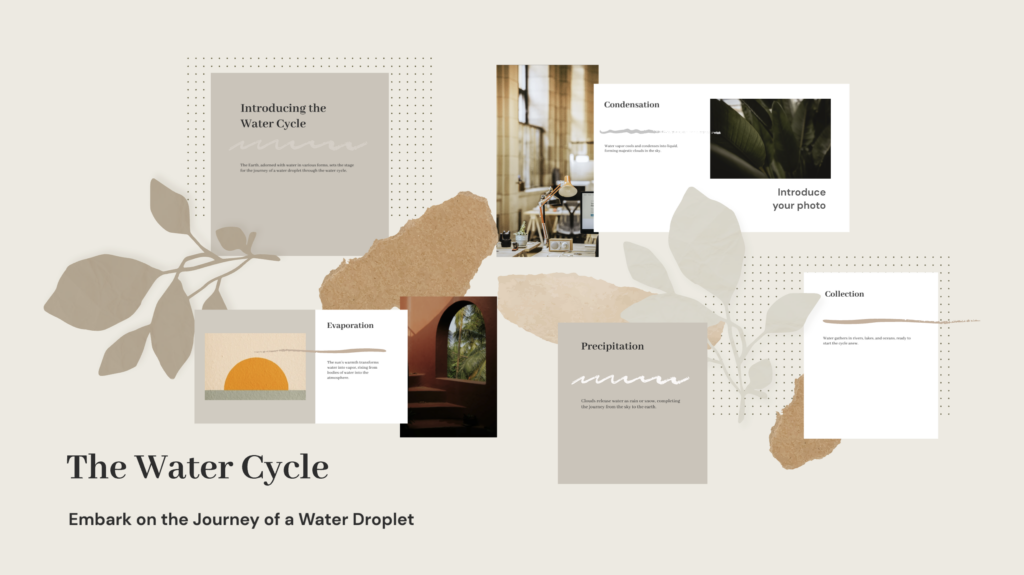
By using each slide to convey these points, the student can create an engaging storyboard on Prezi, making the water cycle easy to understand and visually appealing. You can use ideas from this storyboard example for your next project.
Storyboard examples for film
If a filmmaker needs to create a storyboard for a short film project, they could organize it by dedicating each slide to show different key scenes and parts of the film’s narrative. Here’s a structured storyboard example:
- First slide: Introduce the protagonist and the setting. Feature an image of the main character, Alex, in their city environment with the caption, “Alex, a young aspiring musician, seeks inspiration amidst the city’s hustle.”
- Second slide: Highlight the inciting incident. Illustrate Alex discovering an old, enchanting music shop with a note, “A mysterious music shop draws Alex in, promising a journey of discovery.”
- Third slide: Detail the story’s progression. Show Alex finding a unique instrument that speaks to him, alongside a description, “A forgotten guitar with a rich history becomes Alex’s muse.”
- Fourth slide: Capture the climax or a significant turning point. Depict Alex performing passionately in an unconventional venue, summarized as, “Alex’s performance under a bridge, transforming the city’s noise into a symphony.”
- Fifth slide: Show the resolution. Present a reflective moment for Alex, with a view of the city skyline behind, and the words, “Alex’s music now weaves through the cityscape, a testament to his growth and inspiration.”
- Sixth slide: Conclude with a thematic or reflective shot. Consider a panoramic city dawn scene, indicating a new beginning, with the caption, “As dawn breaks, the city vibrates with the echoes of Alex’s guitar, heralding a new musical era.”
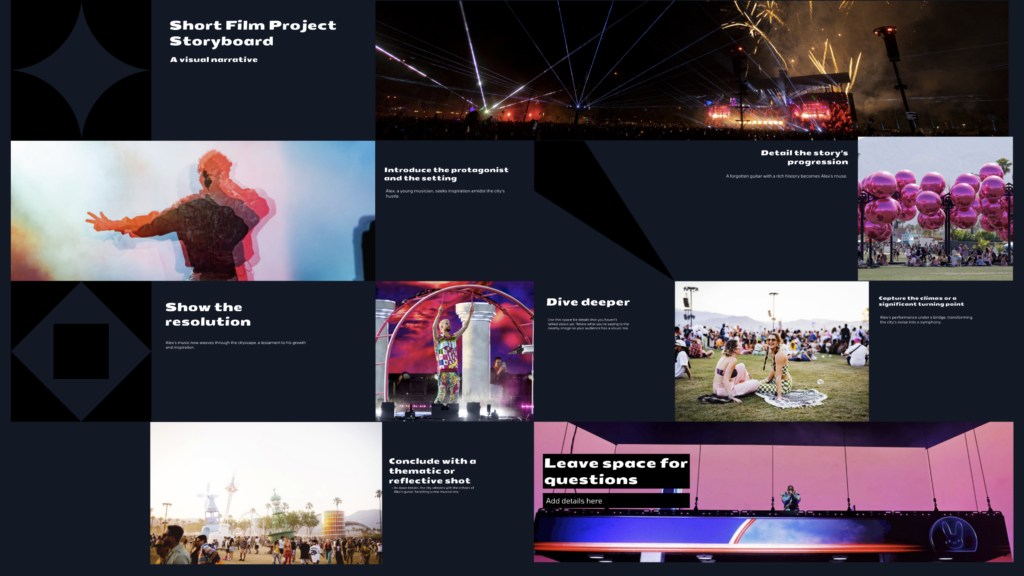
By organizing the storyboard into slides, a filmmaker can visually and textually map out the film’s journey in Prezi. This slide-based approach allows for a dynamic presentation, showcasing the story’s development from the introduction of the character and setting to the climax and resolution, providing a visual guide for what the film will entail.
Storyboard examples for websites
Creating a storyboard for a website design project involves outlining the user journey, key features, and the overall layout of the site. Each slide of the storyboard can be dedicated to a different section of the website, providing a visual guide for the development process. Here’s a storyboard example for a website project:
- First slide: Introduction to the website. This slide is where you would outline the main purpose of the website and who it’s intended for. For example, a cooking blog that offers recipes from around the world for people who enjoy cooking at home.
- Second slide: Homepage overview. Here, you can describe the homepage layout, including essential elements like the navigation menu, highlighted recipes, and a search feature to easily find recipes.
- Third slide: Recipe page details. This slide focuses on the structure of individual recipe pages. It should include sections for the list of ingredients, step-by-step cooking instructions, and a comment section for readers to share their thoughts.
- Fourth slide: Interactive features. This slide can be used to talk about any interactive elements you plan to include, such as quizzes to suggest recipes based on taste preferences or tools for planning meals.
- Fifth slide: Mobile design. It’s important to ensure the website is accessible on various devices. This slide will show how the website’s design adjusts for a user-friendly experience on smartphones and tablets.
- Sixth slide: About and contact information. This part covers the layout and content of the About and Contact pages. It’s where you can share the backstory of the blog and provide a simple way for visitors to get in touch.
- Seventh slide: Design mockups. The final slide presents mockups of the website’s key pages, giving a clear visual of what the website will look like once it’s developed.
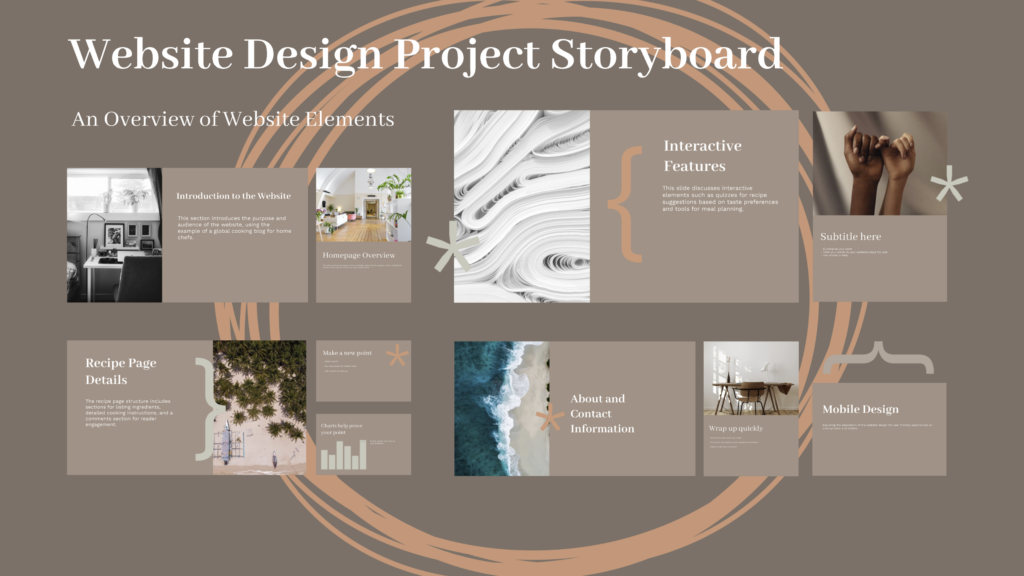
By organizing the storyboard into these clear, straightforward slides, you can methodically plan the website’s layout and features. This approach ensures that the final website will be well-organized, look appealing, and easy to navigate for people of all ages.
Storyboard examples for business
Creating a storyboard for a business project, such as launching a new product or service, can help you visualize and plan your approach. Here’s a storyboard example for a business presentation:
- First slide: Introduction to your business idea. You could start by presenting the core concept of your new product or service. Outline what it is, who it’s for, and why it’s needed in the market. For example, “Introducing a revolutionary gardening tool designed for urban balconies.”
- Second slide: Market need and opportunity. Use this slide to delve into the problem your product solves. Highlight the gap in the market and the research backing your idea. “Why city dwellers struggle with gardening and how our tool changes the game.”
- Third slide: Product features and benefits. Here, detail the key features of your product or service and how it benefits users. Include visuals or diagrams to illustrate how it works. “Our gardening tool’s compact design, easy storage, and versatility.”
- Fourth slide: Target audience and customer persona. You could create a profile of your ideal customer, including demographic details, interests, and needs. This helps personalize your presentation. “Meet Alex, a city dweller with a passion for sustainable living.”
- Fifth slide: Marketing and sales strategy. Outline how you plan to reach your target audience and sell your product. Discuss marketing channels, pricing strategy, and sales forecasts. “Our multi-channel approach to capturing the urban gardener’s attention.”
- Sixth slide: Competitive analysis. Show how your product stands out from competitors. You could use a comparison chart to highlight your product’s unique features and benefits. “Why our gardening tool is the top choice for urban gardeners.”
- Seventh slide: Financial projections and funding. If you’re seeking investment, use this slide to present your financial projections and funding needs. Include key metrics like projected sales, costs, and the investment you need. “The path to profitability: How your investment will help us grow.”
- Eighth slide: Next steps and call to action. Conclude with the immediate next steps for launching your product and a call to action for your audience, whether it’s seeking investment, partnerships, or feedback. “Join us in revolutionizing urban gardening. Let’s grow together.”
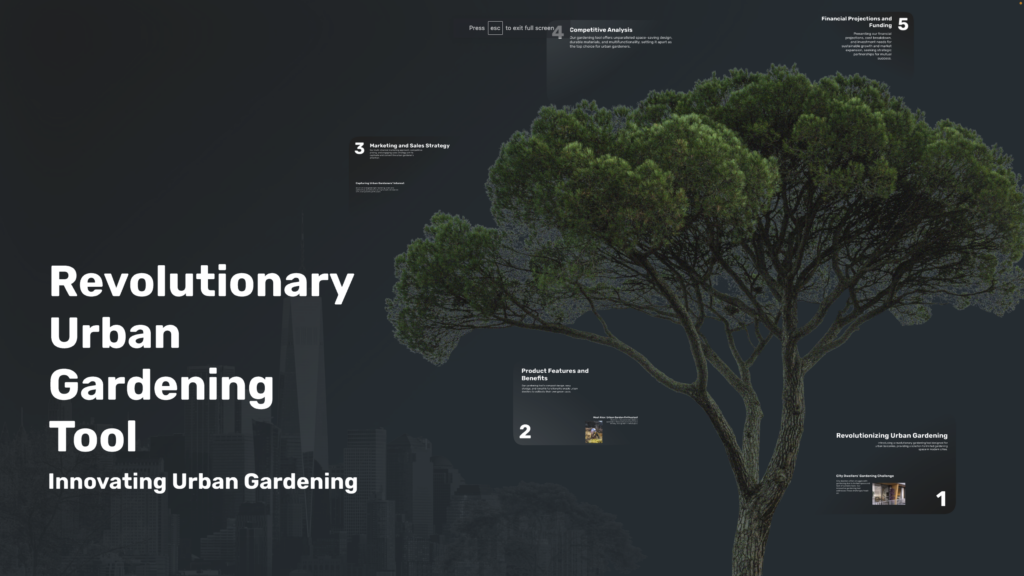
By following a storyboard example like this one, you can create a simple yet persuasive business presentation. This approach allows you to clearly show your idea, its market potential, and how you plan to succeed, engaging your audience every step of the way.
Storyboard examples for advertising
Creating a storyboard for an advertising campaign allows you to map out your story, key messages, and visual strategy. Here’s a structured storyboard example for a successful advertising presentation:
- First slide: Campaign overview. Begin with a brief introduction to the advertising campaign, including the product or service you’re promoting, the campaign’s goals, and the key message you want to explain. For instance, “Launching our eco-friendly water bottle: Aimed at reducing plastic use and promoting sustainability.”
- Second slide: Target audience. Use this slide to describe the demographic and characteristics of your target audience. Understanding your audience is crucial for tailoring your message. “Our ideal customer: Environmentally conscious, active lifestyle, ages 20-35.”
- Third slide: Key message and value proposition. Highlight the main message of your campaign and what sets your product apart from others. This is the core of your campaign that you want your audience to remember. “Stay hydrated, save the planet: Our water bottle’s unique, sustainable design.”
- Fourth slide: Creative concept. Introduce the creative theme or concept of your campaign. This could include the visual style, tone of voice, and the emotional or rational appeal you’re using. “Visualizing sustainability: A world where every sip makes a difference.”
- Fifth slide: Media channels. Outline which media channels you’ll use to distribute your campaign, such as social media, TV, print, or outdoor advertising. Tailor your choice of channels to where your target audience is most likely to engage with your message. “Our multi-platform approach: From Instagram stories to billboard ads.”
- Sixth slide: Execution details. Dive into the specifics of how each part of your campaign will be executed. This might include scripts for commercials, layouts for print ads, or content plans for social media. “Behind the scenes: Crafting messages that resonate on every platform.”
- Seventh slide: Timeline and milestones. Provide a timeline for your campaign, including key milestones, such as launch dates, special events, or promotional offers. This helps keep your campaign organized and on track. “From kickoff to impact: Our roadmap for the next three months.”
- Eighth slide: Measurement and success criteria. Conclude with how you plan to measure the success of your campaign, detailing the metrics and KPIs you’ll track. “Defining success: Engagement, sales, and the ripple effect of change.”
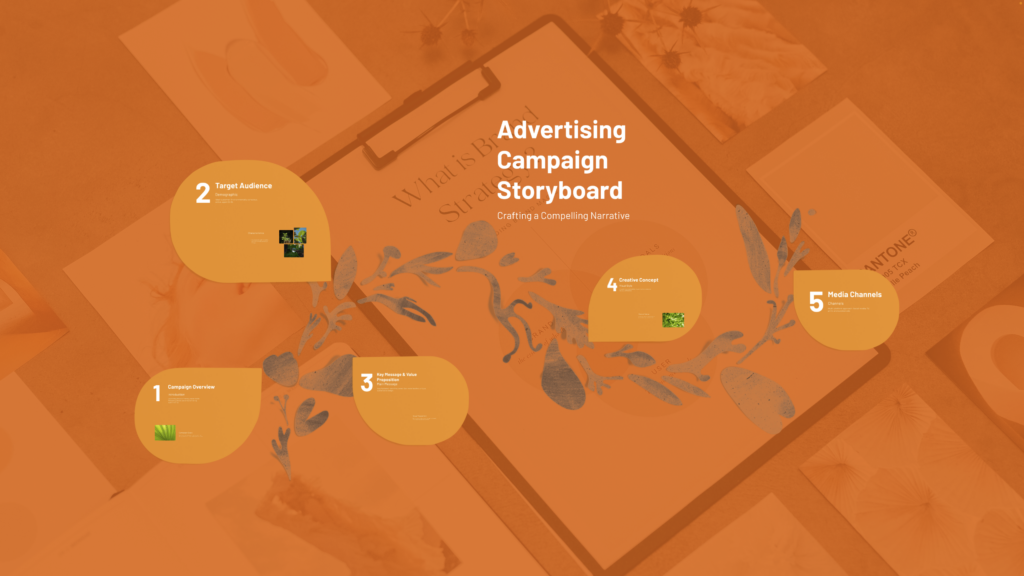
By taking inspiration from this storyboard example, you can develop a clear advertising campaign that communicates your message well, engages your target audience, and achieves your marketing goals. This structured approach ensures that every section of your campaign is aligned and contributes to the overall objectives.
Using Prezi templates to bring your storyboard ideas to life
One of the best things about Prezi is that there are plenty of presentation templates to choose from that can be tailored to fit the theme of your storyboard. Here are a few templates that could be molded to suit your own storyboard ideas:
Storytelling presentation template
This template is designed with pre-defined prompts on each slide, guiding you on what to include for telling your story effectively. It’s ideally suited for storyboard presentations, enabling you to use each slide to easily present the next part of your message, ensuring clarity and ease of understanding for your audience. This template also offers customization options, such as adding a brand logo and company name, making it a great choice for business-related storyboards.
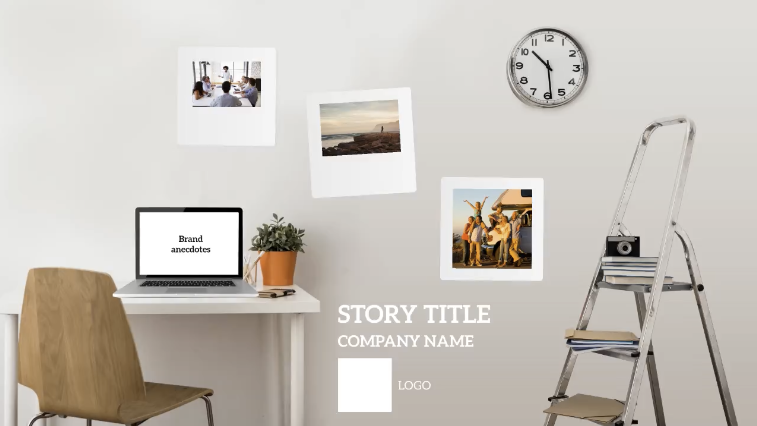
Newspaper presentation template
This template looks like a newspaper, putting the big stories upfront. As you move through the presentation, you get to dive into the details of each story, just like reading further into a newspaper. It’s perfect for laying out your main ideas at the start and then going deeper into each one. With Prezi, you can zoom in on specific parts instead of just clicking on the next slide. This zooming feature makes your presentations more engaging and is great for sharing storyboards in a way that grabs attention.
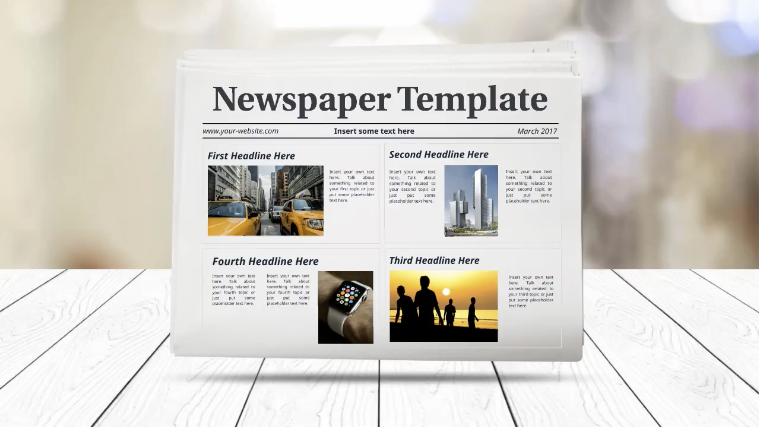
Whiteboard-themed lesson plan template
This presentation template, with its sticky note and whiteboard theme, is great for storyboard presentations. It lets teachers break down lessons into sections, each telling the next part of the story. This approach turns complex topics into engaging stories, making it easier for students to follow and understand. By presenting information in a clear sequence, students are more likely to stay interested and remember the lessons.
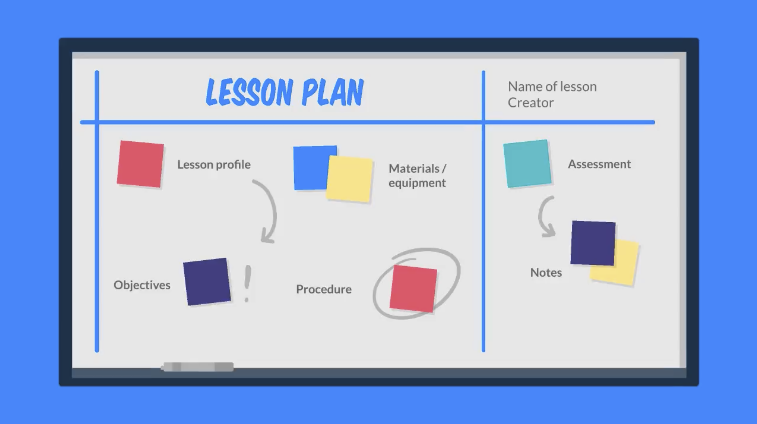
Real storyboard examples made with Prezi
With Prezi’s versatile platform, it’s easy to turn any presentation into an interesting storyboard with the help of Prezi’s advanced features and tools. Here are some storyboard examples that real users have created.
Storyboard example #1: the 20 new leadership books for 2020
This Prezi, based on Adam Grant’s selection of leadership books for 2020, is a good storyboard example and showcases how to turn a presentation into a story. Adam organizes the books around themes such as problem-solving and relationships, guiding the audience through each topic like chapters in a story. The presentation uses Prezi’s capabilities to zoom and pan between sections, making the journey through the content interactive and smooth. This storytelling approach helps break down complex ideas into an interesting narrative, keeping the audience interested and making the information stick. It’s a clear example of how presentations can be more than just slides, transforming them into dynamic stories that captivate and educate.
Storyboard example #2: coffee time
The “Coffee Time” presentation created using Prezi is a storyboard example of the evolution of coffee. It takes you on a journey from where coffee began to how it has changed over time. It’s laid out like a timeline, so it’s easy to follow along, just like reading a story. Each part of the timeline tells you something new about coffee, like where it came from and how it became popular. This way of presenting information like a storyboard makes it simple for anyone to understand, so the message can resonate widely.
Storyboard example #3: 100 years of geological mapping in the Netherlands
This is a great storyboard example because it takes the audience on a journey through time, just like a story would. Starting in 1844 and spanning to 2018, each section of the presentation explains how geographical mapping has evolved over the years. It’s set up like chapters in a book, where each chapter reveals new developments and changes in mapping technology and practices. This storytelling format makes it easy for the audience to follow along and understand the progression of geographical mapping in the Netherlands. It’s like reading a history book, but with maps and pictures to help illustrate the changes over time.
Try a new approach to your presentations using inspiration from Prezi storyboard examples
Embracing a storyboard approach in your presentations offers a powerful way to connect with your audience, regardless of your background or profession. Whether you’re a teacher planning your next lesson or a business professional aiming to engage corporate clients, storyboards provide a simple yet effective way to convey your message.
Storyboards ensure that your audience remains attentive and engaged throughout by simplifying complex ideas and keeping things clear. Take inspiration from the storyboard examples discussed and consider implementing this approach in your next Prezi presentation. So, whether you’re sharing stories in the classroom or pitching ideas in the boardroom, let the storyboard be your guide to impactful communication.
